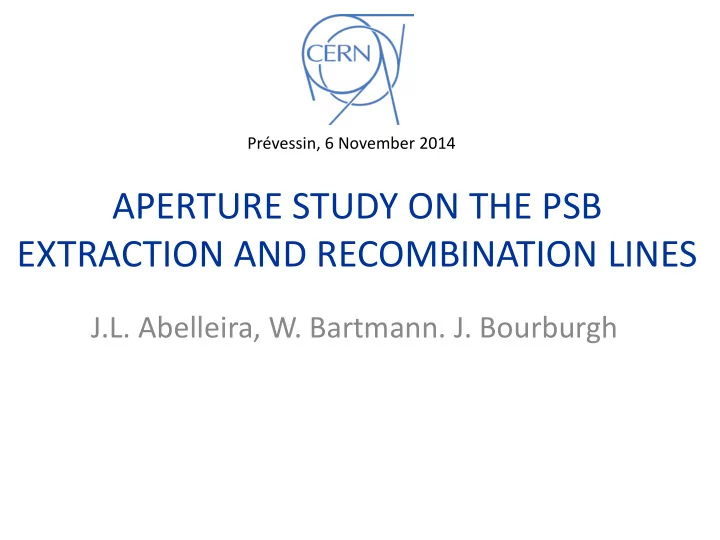

Prévessin, 6 November 2014 APERTURE STUDY ON THE PSB EXTRACTION AND RECOMBINATION LINES J.L. Abelleira, W. Bartmann. J. Bourburgh Thanks to: g
• Aperture study of present septa • Comparison with future septa • Study including extraction • Study possibilities to increase aperture (more kicker strength…) • Could we install the lengthened septa in the present machine? APERTURE SPECIFICATION OF PSB-PS RECOMBINATION SEPTA 2
The BT transfer line SMV10 SMV20 From PS BOOSTER 3 septa 1.4 GeV 2.0 GeV B x1.3 Bdlx1.3 995 1225 1064 1300 APERTURE SPECIFICATION OF PSB-PS RECOMBINATION SEPTA 3
B B APERTURE SPECIFICATION OF PSB-PS RECOMBINATION SEPTA 4
Beam size definition Beam size definition (Half) beam sizes computed as 𝜗 𝑂;𝑦,𝑧 𝛾 𝑦,𝑧 γ 𝑠 β 𝑠 + | 𝐸 𝑦,𝑧 σ | + 𝐷𝑃 ∙ 𝐵 𝑦,𝑧 = 𝑜 𝑡𝑗 ∙ 𝑙 𝛾 ∙ 𝛾 𝑦,𝑧 ∙ 𝛾 𝑁𝐵𝑌;𝑦,𝑧 CO = 1.5 mm E k = 1.4 GeV 𝑙 𝛾 = 1.2 𝜗 𝑂,𝑦 [ m] 𝜗 𝑂,𝑧 [ 𝑛] 𝜏 1.07x10 -3 LHC 2 2 1.35 x10 -3 Fixed target 10 5 1.35 x10 -3 ISOLDE 15 9 APERTURE SPECIFICATION OF PSB-PS RECOMBINATION SEPTA 5
Orbit comparison Element Present [mrad] Upgraded [mrad] dbt1bvt10 Bending magnet 76.80 75.27 dbt1smv10 Septum 73.56 72.03 dbt4bvt10 Bending magnet 76.80 75.27 dbt4smv10 Septum 73.56 72.03 dbtbvt20 Bending magnet 74.17 72.82 dbtsmv20 Septum 71.31 69.96 future septum In order to to keep same orbit at SMV exit, trajectories are Present rematched septum APERTURE SPECIFICATION OF PSB-PS RECOMBINATION SEPTA 6
Gap height Gap width blade thickness (horizontal plane) [mm] (vertical plane) [mm] [mm] Present 60.4 102 5 Upgraded 60.4/62.0 102 5 APERTURE SPECIFICATION OF PSB-PS RECOMBINATION SEPTA 7
Wider septa apertures do not allow more beam n sig =1.5 n sig =1.0 n sig =2.0 n sig =2.5 n sig =2.3 Limitation in septum blade, coming from distance between beam centers No Limitation here APERTURE SPECIFICATION OF PSB-PS RECOMBINATION SEPTA 8
1. BT1.SMV10 PRESENT FUTURE Blade: 5 mm ISOLDE Fixed target LHC Vertical Present 2.6 3.5 5.6 Upgraded 2.5 3.4 5.4 Horizontal Present 2.5 3.1 7.1 Upgraded 62.0 mm 2.6 3.1 7.2 Upgraded 60.4 mm 2.5 3.1 7.0 APERTURE SPECIFICATION OF PSB-PS RECOMBINATION SEPTA 9
1. BT4.SMV10 PRESENT FUTURE ISOLDE Fixed target LHC Vertical Present 2.6 3.5 5.6 Upgraded 2.5 3.4 5.5 Horizontal Present 2.5 3.1 7.1 Upgraded 62.0 mm 2.6 3.1 7.2 Upgraded 60.4 mm 2.5 3.1 7.0 APERTURE SPECIFICATION OF PSB-PS RECOMBINATION SEPTA 10
BT.SMV20 PRESENT FUTURE ISOLDE Fixed target LHC Vertical Present 2.0 2.7 4.2 Upgraded 1.9 2.6 4.2 Horizontal Present 3.0 3.9 8.7 Upgraded 62.0 mm 3.1 3.9 8.8 Upgraded 60.4 mm 3.0 3.8 8.6 APERTURE SPECIFICATION OF PSB-PS RECOMBINATION SEPTA 11
Extraction septum • No additional limitation found in PSB extraction septum BE.SMH (3.0 σ x , 5.5 σ y for ISOLDE beam) • No additional limitation found in extraction kicker Circulating beam Extracted beam APERTURE SPECIFICATION OF PSB-PS RECOMBINATION SEPTA 12
Recombination orbits As the limitation comes from the distance at the exit of the septa, more beam will fit if the distance is increased Recombination quadrupole of integrated strength k l f = 1 𝑙 𝑚 But this fights against the kickers, as more kicker strength is needed! LIU-ABT systems : PS. Beam parameters 13
Recombination orbits Another solution would be to move the quadrupole, but not enough space between septa and quad For these reasons, the present recombination geometry is kept. LIU-ABT systems : PS. Beam parameters 14
Situation with present beams Richard Catherall • For the moment (and for the last 10 years) there are no specific requests for a primary proton beam energy at 1.0 GeV for any experiments at ISOLDE . • The 1 GeV beam is therefore not essential to the ISOLDE physics program and to the best of my knowledge, there are no plans to request this primary beam energy in the future. • The possibility to switch between 1.4GeV and 2 GeV is of great importance as the different energies are required for an optimal production of specific isotopes. Could we install the magnets during this RUN 2? worst-case energy case would be the same: 1.4 GeV I expect a very small difference in beam losses from the present situation. - I will give the exact number. APERTURE SPECIFICATION OF PSB-PS RECOMBINATION SEPTA 15
Conclusions • With the present recombination geometry, the limiting factor in aperture is the distance between the center of deflected and undeflected beams at the exit flange of the septum. • For the reason explained above, an increase on the gap width is not justified. • With the new septa there is a small reduction in the vertical aperture that comes from the increase in length, but this value is very small (in the order of 1/10 sigma) • An increase of the gap height (horizontal aperture) gives a very small gain (1/10 sigma in the best case) so in principle is better to keep the same dimension. APERTURE SPECIFICATION OF PSB-PS RECOMBINATION SEPTA 16
Recommend
More recommend